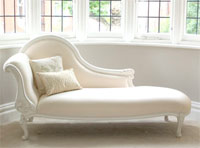Sign up to receive the latest news from Sweetpea & Willow, including new arrivals, exclusive discounts and more.
* Full priced products only. Excludes certain brands. T&C apply.

The excesses and hedonism of the eighteenth century in France led to public dissatisfaction and discontent, culminating in the French Revolution. For the revolutionaries Neoclassicism was a way of expressing their desire for a unified society embracing the stoic virtues of selflessness and loyalty. With the rise to power of Napoleon Bonaparte Neoclassicism looked instead to the pomp and power of the Roman Empire, embracing its strength, order and authority.
In contrast with the Baroque and the Rococo, Neoclassical paintings eschew pastel colours and soft-focus; instead, they use clear colours, deep shadows and sharp contours.
A sense of gravitas was expressed through furniture and design that was intended to expunge the memories of the frivolous Rococo style. Upholstered and gilded chairs and sofas resemble thrones and exemplify a certain Napoleonic grandeur. Classical carved urns enlivened and provided structure for garden layouts.
Neo-classicism provides a grand statement with an element of restraint, a perennial favourite throughout history.